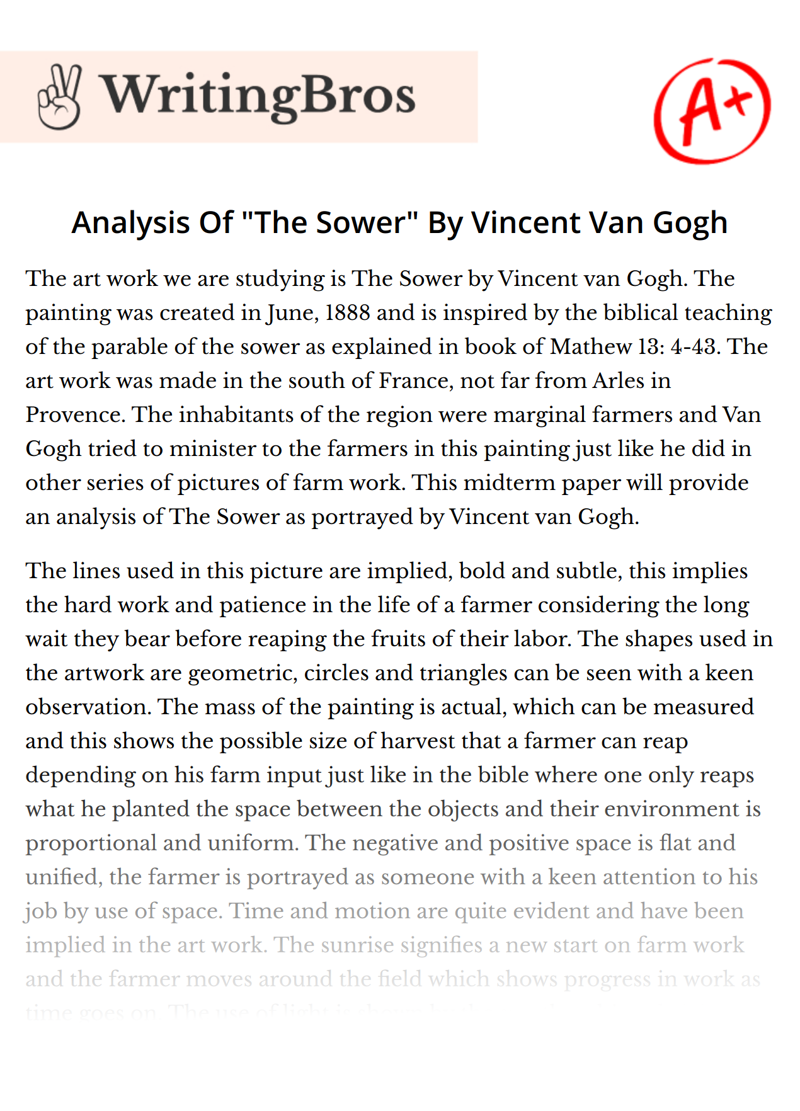Analysis Of "The Sower" By Vincent Van Gogh

The art work we are studying is The Sower by Vincent van Gogh. The painting was created in June, 1888 and is inspired by the biblical teaching of the parable of the sower as explained in book of Mathew 13: 4-43. The art work was made in the south of France, not far from Arles in Provence. The inhabitants of the region were marginal farmers and Van Gogh tried to minister to the farmers in this painting just like he did in other series of pictures of farm work. This midterm paper will provide an analysis of The Sower as portrayed by Vincent van Gogh.
The lines used in this picture are implied, bold and subtle, this implies the hard work and patience in the life of a farmer considering the long wait they bear before reaping the fruits of their labor. The shapes used in the artwork are geometric, circles and triangles can be seen with a keen observation. The mass of the painting is actual, which can be measured and this shows the possible size of harvest that a farmer can reap depending on his farm input just like in the bible where one only reaps what he planted the space between the objects and their environment is proportional and uniform. The negative and positive space is flat and unified, the farmer is portrayed as someone with a keen attention to his job by use of space. Time and motion are quite evident and have been implied in the art work. The sunrise signifies a new start on farm work and the farmer moves around the field which shows progress in work as time goes on. The use of light is shown by the sun that shines brightly in comparison to the other parts of the land that seems dark. This shows the importance of the sun in a farmer’s life. The colors used are bright and this signifies optimism that the farmer’s work will bear fruits in future. The general texture of the art seems rough, and this portrays the obstacle and hard work in a framer’s life. It is not a smooth sailing for him.
In terms of design, there is variety in the piece considering the different colors, light and objects in the work. The balance is symmetrical as no part of the artwork seems to overpower the other. The emphasis is put on the sun, and subordination is on the millet plants. This shows that the sun is useful for the growth of the plants. The force applied by the artist is indirect. There is contrast in the art considering the coordination of colors and the different size of objects in the art. There is rhythm and pattern in how the colors have been applied. This portrays an order on the activities of the farmer. In terms of scale, the objects are life-sized and seems natural, the sun and the farmer are of normal sizes. The size brings a natural feeling to the art, and we can easily relate to the farmer’s life.
To finish things off, the artwork gives us a glimpse into the cycles of a framer’s life. In my interpretation, time, hard work, and persistence are required in a farmer’s life, and the amount of input in terms of these elements is what determine the produce. Just like the parable of the sower in the Bible, The Sower by Vincent van Gogh shows that a farmer or anybody reaps what he sows.
Cite this Essay
To export a reference to this article please select a referencing style below

